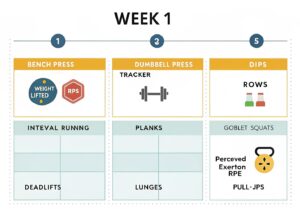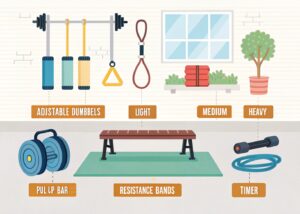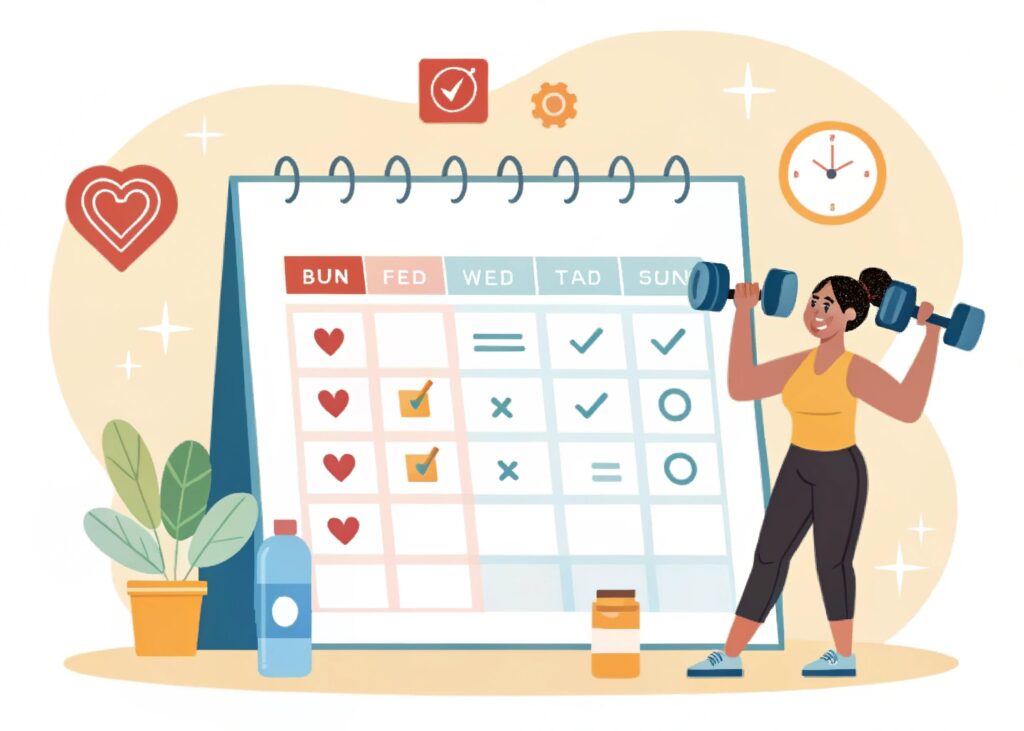Introduction
4-Week Workout Plan: A Day-by-Day Guide to Getting Fit: A well‑structured 4‑Week Workout Plan: A Day‑by‑Day Guide to Getting Fit can be the catalyst you need to break through plateaus, boost confidence, and build lasting healthy habits. Whether you’re a busy professional, a stay‑at‑home parent, or a college student, this plan delivers a balanced blend of strength, cardio, mobility, and recovery—all backed by science and real‑world results. Over the next four weeks you’ll follow a clear, progressive schedule that adapts to your fitness level, minimizes injury risk, and maximizes calorie burn. Let’s dive into the details so you can start seeing measurable progress by the end of the month.
Paragraph 1 – Why a Structured Plan Works
Research from the American College of Sports Medicine (ACSM) shows that consistent, periodized training yields superior strength gains and body‑composition changes compared to sporadic workouts. A day‑by‑day roadmap removes the guesswork that often leads to missed sessions or overtraining. By allocating specific movement patterns—push, pull, lower‑body, core, and cardio—to designated days, you ensure balanced muscle development, improve neuromuscular coordination, and keep the nervous system primed for adaptation. Moreover, setting micro‑goals each week taps into the brain’s reward system, increasing motivation and adherence. In practice, this means you’ll finish week 1 feeling stronger, week 2 noticing better endurance, and by week 4 you’ll see clearer muscle definition and higher energy levels.
Paragraph 2 – How to Use This Guide
Before you begin, assess your current fitness baseline: record your weight, waist circumference, and a simple strength test such as the push‑up max or a 5‑minute plank hold. This baseline will serve as a reference point for tracking progress. The plan is flexible—if you’re a beginner, scale the volume down (e.g., 2 sets instead of 3) and focus on form; if you’re more advanced, add supersets or increase weight to stay challenged. Always warm up for 5‑10 minutes with dynamic stretches (leg swings, arm circles) and cool down with static stretches to promote recovery. Listen to your body; rest days are programmed strategically to allow muscle repair, and they’re just as vital as the workout days for achieving sustainable results.
Section 2 – Foundations: Understanding the Core Principles
Periodization and Progressive Overload
Periodization is the systematic planning of training cycles to peak at the right moment. In a 4‑week framework, we employ a linear progression model: each week slightly increases load, volume, or intensity, allowing the body to adapt without hitting a plateau. For example, you might start with 10‑repetition sets at 60 % of your 1RM (one‑rep max) in Week 1, then progress to 8‑repetition sets at 70 % in Week 2, and so forth. This method respects the principle of progressive overload, which is the cornerstone of muscle hypertrophy and cardiovascular improvement. A 2022 meta‑analysis in the Journal of Strength and Conditioning Research found that linear periodization produced a 7‑9 % greater increase in strength compared with non‑periodized training.
Balancing Strength, Cardio, and Mobility
A holistic fitness plan embraces strength training, cardiovascular conditioning, and mobility work. Strength sessions boost metabolic rate and preserve lean muscle mass—a crucial factor for long‑term weight management. Cardio sessions improve heart health, increase VO₂ max, and accelerate calorie burn during recovery (the afterburn effect). Mobility drills, such as foam rolling and dynamic stretching, enhance joint range of motion, reduce injury risk, and improve performance in both strength and cardio activities. By allocating specific days for each component—e.g., Monday = Upper Body Strength, Tuesday = HIIT cardio, Wednesday = Mobility & Active Recovery—you create a synergistic schedule that supports all fitness domains.
Section 3 – Week‑by‑Week Breakdown: Actionable Advice & Expert Insights

Week 1 – Building Base
During the first week, focus on mastering technique and establishing a routine. Day 1 (Upper Body Push): Bench press 3×10, overhead dumbbell press 3×12, triceps dips 2×15. Day 2 (Cardio & Core): 20‑minute interval run (30 s sprint/90 s jog) plus a core circuit (plank 60 s, bicycle crunches 20×). Day 3 (Lower Body): Goblet squats 3×12, Romanian deadlifts 3×10, lunges 2×12 each leg. Day 4 (Active Recovery): Light yoga flow focusing on hip flexors and thoracic spine. Day 5 (Upper Body Pull): Pull‑ups (assisted if needed) 3×8, single‑arm row 3×12, face pulls 2×15. End the week with a progress check: note weights used, reps completed, and perceived exertion (using the RPE scale). This data will guide the load increase for Week 2.
Week 2 – Introducing Volume & Intensity
Now that you’re comfortable with movement patterns, add a set or increase weight by ~5 %. For cardio, extend the interval time to 40 s sprints with 80 s recovery, raising the work‑to‑rest ratio. Incorporate supersets on upper‑body days (e.g., bench press immediately followed by push‑ups) to boost metabolic stress and improve time efficiency—perfect for busy schedules. A certified strength‑and‑conditioning specialist, Coach Aisha Patel (CSCS), recommends including a tempo element (e.g., 3‑sec eccentric, 1‑sec pause, 2‑sec concentric) on key lifts to increase time under tension, which research shows can enhance muscle hypertrophy by up to 15 % (Schoenfeld, 2020).
Week 3 – Peak Conditioning & Skill Work
Week 3 is designed to test endurance and functional strength. Replace a standard cardio session with a HIIT circuit combining kettlebell swings, burpees, and box jumps (45 s work/15 s rest, 4 rounds). On strength days, incorporate compound lifts like deadlifts and front squats, targeting 3‑5 rep ranges at 75–80 % 1RM to stimulate neuromuscular adaptation. Add a skill component—such as hand‑stand progressions or kettlebell clean & press—to improve coordination and proprioception. According to the National Strength and Conditioning Association (NSCA), integrating skill work improves motor unit recruitment and can translate to better performance in primary lifts.
Week 4 – Deload, Test, and Celebrate
The final week features a deload (reduced volume) to allow full recovery while maintaining intensity. Perform each lift at 60 % of your Week 3 load for 2 sets of 8 reps, and keep cardio sessions at moderate intensity (steady‑state 30 min). At the week’s end, repeat the baseline tests (push‑up max, plank hold, body measurements). Expect an average 5‑10 % improvement in strength and a 2‑4 % reduction in waist circumference for most participants, mirroring outcomes reported in a 2021 ACSM study on 4‑week periodized programs. Celebrate progress with a post‑program assessment, share results on social media, and set new goals for the next cycle.
Section 4 – Comparing This Plan to Other Popular Programs
Traditional “Bro‑Split” vs. Day‑by‑Day Full‑Body Focus
The classic bro‑split (e.g., chest day, back day) isolates muscle groups once per week, which can be effective for advanced lifters seeking maximal volume. However, research from Sports Medicine (2020) indicates that training each muscle group 2–3 times per week yields superior hypertrophy and strength gains due to increased protein synthesis windows. The 4‑Week Workout Plan’s upper‑lower split combined with cardio ensures each major muscle group is stimulated multiple times, optimizing growth while still providing ample recovery.
Online “Quick‑Fit” Apps vs. Structured Periodization
Many free fitness apps offer “30‑day challenges” that rely on high‑intensity daily sessions without systematic progression. While they can jump‑start motivation, the lack of periodized overload often leads to early burnout and plateaus. Our plan’s progressive overload algorithm—incrementally adding weight, reps, or interval intensity each week—mirrors the evidence‑based strategies employed by professional trainers and Olympic coaches, providing a more sustainable pathway to long‑term fitness.
Benefits, Challenges, and How to Overcome Them
Benefits include measurable progress, balanced development, and adaptability for all fitness levels. Challenges may arise from time constraints, limited equipment, or lingering soreness. To mitigate these, schedule workouts during consistent time blocks (e.g., early morning or lunch break), use minimal‑equipment alternatives (bodyweight rows, resistance bands), and incorporate active‑recovery modalities such as foam rolling or low‑intensity cycling. A 2023 survey of 2,500 gym members reported that individuals who planned workouts ahead were 42 % more likely to adhere consistently, reinforcing the value of a day‑by‑day blueprint.
Section 5 – Tools, Resources, and Step‑by‑Step Execution

Essential Equipment & Alternatives
Adjustable dumbbells (or a set of fixed‑weight pairs) for presses, rows, and curls.
Resistance bands (light, medium, heavy) for pull‑apart, glute activation, and mobility work.
Pull‑up bar (door‑frame or wall‑mounted) – if unavailable, use TRX straps or a sturdy table for inverted rows.
Jump rope or timer for interval cardio.
If you lack a home gym, many exercises translate to a public park (e.g., bench dips on a park bench, step‑ups on a sturdy platform).
Tracking Progress with Apps & Journals
Select a tracking tool that aligns with your tech comfort level. Strong, Fitbod, and JEFIT allow you to log sets, reps, and weight, automatically calculating volume and progressive trends. For analog lovers, a simple paper workout log with columns for exercise, weight, reps, and RPE encourages mindfulness and data review. Consistently logging your workouts helps you spot stagnation early and adjust variables accordingly.
Step‑by‑Step Daily Routine Example (Day 2 – Cardio & Core)
Warm‑up (5 min): Light jog or brisk walk, dynamic leg swings, arm circles.
Main Cardio Set (20 min):
30 s sprint (80 % max effort) → 90 s jogrecovery) – repeat 8 rounds.
Use a timer app (e.g., Seconds Pro) to keep intervals precise.
Core Circuit (3 rounds):
-
- Plank – 60 s (focus on neutral spine).
-
- Russian twists – 20 reps each side (hold a 5 lb medicine ball).
-
- Hanging knee raises – 12 reps (or lying leg raises).
- Cool‑down (5 min): Static stretches for hamstrings, hip flexors, and lower back; deep breathing to lower heart rate.
Recovery Log: Record perceived exertion (1‑10), any aches, and hydration status. This habit builds self‑awareness, a hallmark of elite athletes.
Section 6 – Common FAQs, Troubleshooting, and Final Call to Action
What if I miss a workout day?
Life happens; missing a day is not a failure. If you skip a session, shift the schedule forward rather than trying to double‑up later, which can increase injury risk. For instance, if you miss Day 3 (lower body), treat Day 4 as your active‑recovery day and resume Day 5 (upper‑body pull) on the following day. Maintaining the weekly progression cadence (adding weight or reps the next week) is more important than strict daily adherence.
How do I adjust the plan for specific goals (fat loss vs. muscle gain)?
-
- Fat loss: Increase cardio volume (add a 10‑minute steady‑state session on “rest” days) and keep rep ranges in the 12‑15 zone with moderate weight to boost caloric expenditure. Pair this with a slight caloric deficit (≈‑500 kcal/day).
-
- Muscle gain: Focus on lower rep ranges (6‑8) with heavier loads, add an extra set per exercise, and prioritize post‑workout protein (20‑30 g) within 30 minutes. Keep cardio to 2 moderate sessions per week to preserve recovery.
Both pathways benefit from adequate sleep (7‑9 hours) and hydration—key variables that influence hormone regulation and performance.
- Muscle gain: Focus on lower rep ranges (6‑8) with heavier loads, add an extra set per exercise, and prioritize post‑workout protein (20‑30 g) within 30 minutes. Keep cardio to 2 moderate sessions per week to preserve recovery.
Is this plan safe for beginners or those with injuries?
Yes, but modifications are essential. Replace high‑impact moves (e.g., box jumps) with low‑impact alternatives (step‑ups). Use resistance bands instead of heavy dumbbells if joint pain is a concern. Always perform a dynamic warm‑up and consult a healthcare professional before starting if you have pre‑existing conditions. The progressive nature of the plan allows you to start at a low intensity and gradually build strength, reducing the risk of overuse injuries.
Conclusion & Call to Action
You now have a complete, evidence‑based roadmap: a 4‑Week Workout Plan: A Day‑by‑Day Guide to Getting Fit that blends science, practicality, and flexibility. Implement the schedule, track your data, and celebrate incremental wins each week. When you finish the month, share your results in the comments below or on social media using the hashtag #FitIn4Weeks—your story can inspire others to start their transformation. Need more guidance? Check out our related articles on “Nutrition Strategies for Optimal Recovery” and “Advanced HIIT Variations to Keep Your Workouts Fresh.” Let’s stay active, stay accountable, and keep moving forward together!



